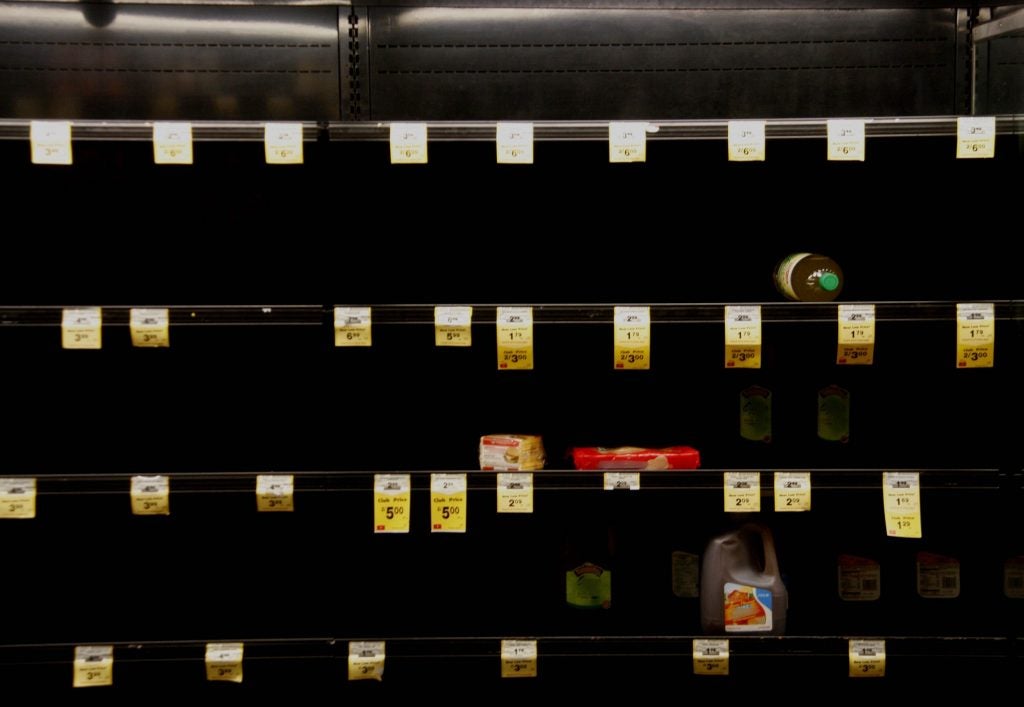COVID-19 is upending the food supply chain. Thousands of workers have been infected. Businesses have shut down. Supplies of meats and other labor-intensive foods are tightening, while a surplus of perishable milk and crops has been dumped or left in fields to rot.
This is a nightmare for farmers, workers and consumers.
Meanwhile, farmers and food providers are working tirelessly and making profound sacrifices to keep Americans and the world fed — often without sufficient personal protective equipment, healthcare or paid sick leave.
Everyone has a stake in keeping the food supply chain intact, with the expectation that health remains the top priority. But it’s become increasingly clear that we can’t return to business as usual once the pandemic eases. We need a more resilient food supply chain that can quickly adapt and prosper, even during major disruptions.
Here are three ways policymakers and corporate leaders can help to rebuild a more resilient agriculture and food system.

(Photo credit: David King)
1. Get food to where it’s needed most.
Policymakers and business leaders should work together to support the development of secondary markets for surplus food to simultaneously reduce food waste, provide a reliable supply for food banks and create thousands of jobs.
Sen. Kirsten Gillibrand’s proposal to allocate $8 billion in the next coronavirus aid package to help food banks buy fresh foods directly from farms is a good start.
Policymakers should seek additional ways to improve access to fresh fruits and vegetables for those in need while creating new revenue streams for farmers. This could include supporting amendments to the Supplemental Nutrition Assistance Program to ensure broad eligibility during the pandemic, as well as permanent changes that make vouchers easier to use at food banks, online and for Community Supported Agriculture.
There are also opportunities for leading businesses to help eliminate food waste by connecting farms and food banks, and donating excess food that hasn’t sold. For example, Walmart has been helping facilitate such food donations to Feeding America for years, purchasing refrigerated trucks for the nonprofit to safely transport food to food banks.
2. Support diversification across the supply chain.
From how our food is grown to how it’s delivered, we need greater diversification and collaboration to reduce risk and increase system capacity to respond to change.
When food companies are more connected with their supply chains — down to the farmers in the field — it allows supply and demand signals to flow more smoothly and adjust production and crop types quickly when disaster strikes.
But it’s not just about reacting to problems, it’s also about rewarding farmers for conservation practices that consistently deliver a host of benefits in terms of risk reduction and environmental stewardship.
For example, farms with extended, diverse crop rotations have a variety of revenue streams in any given year, which protects them if one of the crops suffers from a weather or market disruption. Studies also show that diverse farms can build soil health and reduce their reliance on inputs like fertilizer, which benefits water quality.
As stimulus packages are considered on Capitol Hill, policymakers and business leaders should be looking to support diverse farms of all sizes to improve efficiency, reduce risk and reinvigorate local economies.
How policymakers and corporate leaders can reduce risk and boost resilience across the U.S. food and agriculture sector. Share on X3. Accelerate resilience through public policy.
Policymakers can also support diversification and resilience by reexamining federal programs like the Farm Safety Net, Federal Crop Insurance and Farm Service Agency loans to encourage planting practices that reduce risk.
For example, multiple analyses show how on-farm conservation practices like cover crops, no-till and precision agriculture deliver value far beyond the farm — value that will remain when we come out of the pandemic and perhaps become even more critical to farmers’ bottom lines from the perspective of reduced costs and risk, increased yield resilience and diversified income streams.
Public support for these practices can give American farmers — and the entire food supply chain — a leg up when future economic and environmental disruptions occur, and help prevent a boom and bust job cycle.
Policymakers at the federal, state and local levels should also be leveraging emergency funds to invest in natural infrastructure solutions that can help prevent future disasters, like the historic floods that devastated farmers in the Midwest last year, ruining harvests and killing livestock.
Research shows every $1 invested before a disaster can save $6 in post-disaster recovery, so by investing in the resilience of America’s agricultural lands, policymakers would be saving taxpayer dollars and protecting lives and livelihoods.
We can’t begin to know all the ways COVID-19 will have lasting impacts on our country and our economy, but these no-regret, near-term opportunities can hopefully help mitigate some of the worst impacts to our nation’s food system and build resilience for the future.










2 Comments
I would like to participate in any webinars or trainings associated with Innovations In Supply Chains.
Regards
Catherine
Thanks, Catherine. I recommend signing up for our Supply Chain Solutions Center: https://supplychain.edf.org/